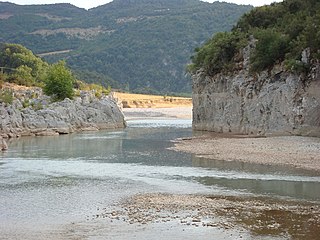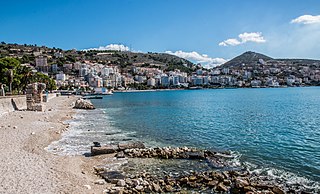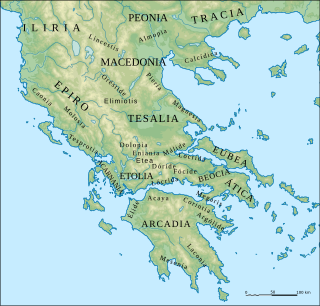Related Research Articles

Epirus is a geographical and historical region in southeastern Europe, now shared between Greece and Albania. It lies between the Pindus Mountains and the Ionian Sea, stretching from the Bay of Vlorë and the Acroceraunian Mountains in the north to the Ambracian Gulf and the ruined Roman city of Nicopolis in the south. It is currently divided between the region of Epirus in northwestern Greece and the counties of Gjirokastër and Vlorë in southern Albania. The largest city in Epirus is Ioannina, seat of the Greek region of Epirus, with Gjirokastër the largest city in the Albanian part of Epirus.

Acarnania is a region of west-central Greece that lies along the Ionian Sea, west of Aetolia, with the Achelous River for a boundary, and north of the gulf of Calydon, which is the entrance to the Gulf of Corinth. Today it forms the western part of the regional unit of Aetolia-Acarnania. The capital and principal city in ancient times was Stratos. The north side of Acarnania of the Corinthian Gulf was considered part of the region of Epirus.

The Achelous, also Acheloos, is a river in Epirus, western Greece. It is 220 km (137 mi) long. It formed the boundary between Acarnania and Aetolia of antiquity. It empties into the Ionian Sea. In ancient times its spirit was venerated as the river god Achelous.

Sarandë is a city in the Republic of Albania and the seat of Sarandë Municipality. Geographically, the city is located on an open sea gulf of the Ionian Sea within the Mediterranean Sea. Stretching along the Albanian Ionian Sea Coast, Sarandë has a Mediterranean climate with over 300 sunny days a year.

The Vjosa or Aoös is a river in northwestern Greece and southwestern Albania. Its total length is about 272 kilometres (169 mi), of which the first 80 kilometres (50 mi) are in Greece, and the remaining 192 kilometres (119 mi) in Albania. Its drainage basin is 6,706 km2 (2,589 sq mi) and its average discharge is 195 m3/s (6,900 cu ft/s). The main tributaries are Voidomatis, Sarantaporos, Drino and Shushicë.

Preveza is one of the regional units of Greece. It is part of the Epirus region. Its capital is the town of Preveza.

Elaias Limen, also Elaea or Elaia (Ἐλαία), was a harbour town of Thesprotia in ancient Epirus at the mouth of the Acheron river. The town is mentioned by both Scylax and Ptolemy. The Periplus of Pseudo-Scylax asserts that this was the main port of Thesprotia. The town's site is identified as near Cheimerion.

Phoenice or Phoenike was an ancient Greek city in Epirus and capital of the Chaonians. It was also the location of the Treaty of Phoenice which ended the First Macedonian War, as well as one of the wealthiest cities in Epirus until the Roman conquest. During the early Byzantine period, Phoenice was the see of a bishopric. The city is an archaeological park of Albania and is located on a hill above a modern town which bears the same name, Finiq, in modern southern Albania.

Palairos is an ancient city and a modern town in Aetolia-Acarnania, Greece. The modern village is also known locally by the name of Zaverda (Ζαβέρδα), in official use till 1928. Since the 2011 local government reform Palairos is part of the municipality Aktio-Vonitsa, of which it is a municipal unit. The municipal unit has an area of 205.843 km2. The municipal unit was formed as the independent municipality Kekropia in 1994 from the former communities Palairos and Pogonia, and was expanded with the former communities Vatos, Plagia and Peratia as a part of the 1997 Kapodistrias reform. The name of the municipal unit was changed to Palairos in 2004.

Epirus was an ancient Greek kingdom, and later republic, located in the geographical region of Epirus, in parts of north-western Greece and southern Albania. Home to the ancient Epirotes, the state was bordered by the Aetolian League to the south, Ancient Thessaly and Ancient Macedonia to the east, and Illyrian tribes to the north. The Greek king Pyrrhus is known to have made Epirus a powerful state in the Greek realm that was comparable to the likes of Ancient Macedonia and Ancient Rome. Pyrrhus' armies also attempted an assault against the state of Ancient Rome during their unsuccessful campaign in what is now modern-day Italy.

Elateia or Elatia, also Elatreia or Elatria (Ἐλατρία), was a town of the Cassopaei in Thesprotia, in ancient Epirus, mentioned by Strabo, along with Batiae and Pandosia. It is said to have been a colony of Elis.

Passaron was an ancient Greek city of ancient Epirus. It was founded by the Molossian king Tharrhypas sometime between 420 and 400 BCE as the capital of the Molossian kingdom. As capital, the Molossian kings and the assembled people were accustomed to take mutual oaths, the one to govern according to the laws, the other to defend the kingdom. Later, in 330 BCE, it became the capital of the newfound united kingdom of Epirus until 295 BCE, when Pyrrhus of Epirus moved the capital to Amvrakia. The town was taken by the Roman praetor Lucius Anicius Gallus in 167 BCE.

Panormus or Panormos was an ancient Greek harbor settlement mentioned by the geographer Ptolemy, in Chaonia in ancient Epirus, situated nearly midway between Oricum and Onchesmus. Strabo describes it as a great harbour in the midst of the Ceraunian Mountains.

Phanote or Phanota, or Phanoteia (Φανωτεία), was a strongly fortified ancient Greek town of Chaonia located in the region of Epirus. The town's location was of military/strategic importance as it stood in the midst of a valley surrounded by an amphitheatre of mountains, through which there are only two narrow passes. It lies about halfway between the sea and the Antigonean passes, and was therefore of importance to the Romans when they were advancing from Illyria in 169 BCE. Its site is tentatively located near the modern Raveni.

The regions of ancient Greece were sub-divisions of the Hellenic world as conceived by the Ancient Greeks of antiquity, shown by their presence in the works of ancient historians and geographers or in surviving legends and myths.
Thessaliotis was one of the four districts into which ancient Thessaly was divided. The others were Pelasgiotis, Histiaeotis, and Phthiotis. Thessaliotis corresponded to the central plain of Thessaly and the upper course of the river Peneius, so called from its having been first occupied by the Thessalian conquerors from Epirus. Its major towns were: Pharsalus, Peirasia, Phyllus, Metropolis, Cierium, Euhydrium, and Thetidium.

Elaea or Elaia, also Elea (Ἐλέα), was a town of Thesprotia in ancient Epirus toward the mouth of the Acheron river. The town is mentioned by Ptolemy. Thucydides calls the surrounding district Elaeatis (Ἐλαιατις) and indicates that Ephyra was in the territory of Elaea. Its port was Elaias Limen, literally the "Bay of Elaea", which the Periplus of Pseudo-Scylax asserts was the main port of Thesprotia.
Charadra, also Charadrus or Charadros (Χάραδρος), was a town of ancient Epirus, situated on the road from Ambracus to the strait of Actium. It is also mentioned in a fragment of Ennius: "Mytilenae est pecten Charadrumque apud Ambraciai."
The Epirote dialect is a variety of Northwest Doric that was spoken in the ancient Greek state of Epirus during the Classical Era. It outlived most other Greek dialects that were replaced by the Attic-based Koine, surviving until the first or second century CE, in part due to the existence of a separate Northwest Doric koine.
References
- ↑ "ToposText". topostext.org. Retrieved 2024-04-27.
- ↑ François Charles Hugues Laurent Pouqueville (1820). Travels in Greece and Turkey: Comprehending a Particular Account of the Morea, Albania, Etc.; a Comparison Between the Ancient and Present State of Greece, and an Historical and Geographical Description of the Ancient Epirus. H. Colburn. p. 345. Retrieved 26 November 2020.
![]() This article incorporates text from a publication now in the public domain : Smith, William, ed. (1854–1857). "Athama'nia". Dictionary of Greek and Roman Geography . London: John Murray.
This article incorporates text from a publication now in the public domain : Smith, William, ed. (1854–1857). "Athama'nia". Dictionary of Greek and Roman Geography . London: John Murray.